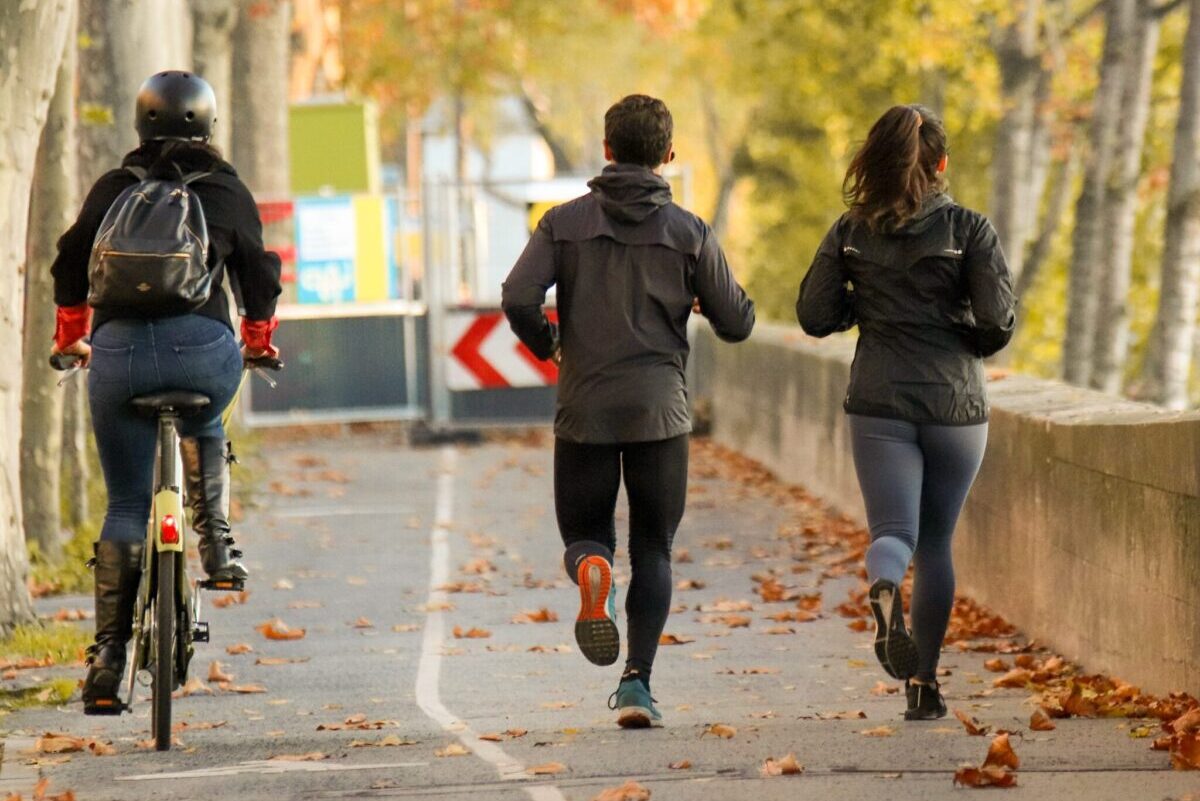Biking and running are two aerobic activities that are excellent at helping you to build discipline, improve mental and physical health, and explore the world.
During my teens and twenties, I would run periodically, changing the intensity and distance based on the pain I experienced in my knees, shins, and feet. I have always dealt with issues related to running but it never stopped me entirely. Then, in my thirties, I quit running after the pain in my lower half became too intense. From there, I switched to biking.
I still prefer running to biking, but biking is more thrilling and much easier on the body.
So where does that leave you?
This article will explore the similarities and differences between these two activities, including research on the benefits of taking part in anaerobic exercises.
The Differences: Biking vs. Running
Biking is Easier on the Body
Overuse injuries are prevalent among runners. It is estimated that 70% of runners will experience an overuse injury each year, with 80% of injuries occurring at or below the knee. Biking is generally a lot easier on the body because it is a low-impact activity.
The exception is if you are riding on trails of moderate to high difficulty. On rough trails, you will likely experience a high degree of impact forcing entering the upper body through the handlebar, affecting your elbows and shoulders. This can be mitigated by choosing a long-travel front fork set to a slower rebound and compression.
If either running and biking cause you too much discomfort, consider swimming. Sometimes it is not worth fighting activities that are not friendly on your body, and swimming is incredibly gentle while still providing an exceptional workout.
Biking Encourages Adventure
Biking is the most efficient form of transportation. For every 100 calories burned, a biker can travel three miles compared to a car traveling 280 feet. Due to this efficiency, you can explore more of your local neighborhoods and trails all without creating greenhouse gas emissions.
A mountain bike is a solid first choice for starting out with biking. Some people go right for a road bike, but I have to argue that a mountain bikes lets you confidently ride on most surfaces, from sidewalks to challenging off-road trails.
Conversely, road bikes will typically limit you to concrete and hard gravel. If you already invested in a road bike and do not want to own two different types of bikes, you could spring for a set of gravel tires. Gavel tires are good for tackling smooth beginner and intermediate trails.
Running May Help Build Stronger Bones
As you age, your bones become more brittle, especially for some post-menopausal women. This is one reason why impact exercises can be good in your youth.
Running causes micro-fractures to form throughout bones in different areas of the body, specifically the spine and lower body. In response, the body fills in these cracks with new bone, which helps to increase bone mass and strength. As a result, your bones may be more resilient to falls or conditions related to bone loss.
But the picture is not perfect. While running can be good for bones, researchers do not agree entirely with the effects of running on bone mineral density (BMD). In fact, running could actually impact bone strength negatively. The reason is that the repetition of running may lead to the bone cells becoming accustomed to the strains associated with repetitive activities – there is a lack of variety in impact forces, leading to bones being strong one way, but not in another way. This could lead to a false sense of confidence prior to a fall.
The news is worse for bikers. Those who bike as a primary form of exercise were found to be seven times more likely to have osteopenia (loss of bone mineral density) of the spine when compared to runners.
If you have concerns about bone health and love to run or bike, you can still work towards strengthening bones by adding weight-bearing activities and impact sports to your weekly routine. Basketball and volleyball are listed as having the most potential benefit on BMD. Soccer and track have a moderate effect. Swimming shows the least effect due to a lack of impact forces on the body.
The conclusion you should draw from this is that running is better than biking if you have concerns about bone health. But with either activity, you should add in a mix of other impact activities to vary the forced placed on your bones so they can become stronger.
Runners Are Impacted Less by Terrain and Weather
Running can be done in various weather conditions and on more challenging terrain than biking. For example, running on trails, hills, and stairs is typically easier than if you were riding a bike. Runners can also enjoy getting caught in the rain storm, while riders should be wary of pushing the limits on surfaces that could become slippery.
Running is Cheap
Running has a low upfront cost. Go to T.J. Maxx and find a pair of cheap running shoes and gym clothes, and then Google the best places to run in your area. Unlike biking, where entry-level bikes start at around $500 before maintenance costs, and can reach $10,000 with the highest quality parts, you may be better off trying running first. This low cost of entry for running also means you are more likely likely to find other people to run with you. People are unsurprisingly resistant to committing to a bike purchase to “try out that cool thing you keep gushing about.”
Health Risks for Runners and Bikers
Before sending you off to try running or biking, do keep in mind the health risks of either activities. None of these injuries are guaranteed or should necessarily concern you too much. But no two bodies are the same, and some people may be at a greater risk of experiencing an injury.
Health risks for runners:
- Overuse injuries such as shin splints, IT band syndrome, and plantar fasciitis
- Joint pain and muscle strains due to the repetitive impact of running on hard surfaces
- Tripping, slipping, and falling due to uneven terrain, obstacles, or inclement weather conditions
- Dehydration and heat stroke, especially when running in hot and humid environments
- Traffic accidents when running on roads or crossing intersections
Runners are also at a higher risk of disruptive inflammation. Research found that between competitive bikers and runners who exercised 2-½ hours a day for three days a week, runners had between 133 and 404% more muscle damage, inflammation levels were 256% higher, and muscle soreness was reported as significantly higher during the following 38-hour recovery period. So if you are a runner, recognize the impact of your training regimen on your body and ensure you recover adequately before heading out again. Scaling back your running may reduce your risk of inflammation, but always be aware that running places a greater strain on the body at any intensity or frequency.
Health risks for bikers:
- Accidents and collisions with other vehicles, pedestrians, or objects
- Road hazards such as potholes, gravel, debris, or wet leaves
- Overuse injuries such as hand numbness, lower back pain, knee pain, and wrists, elbows, and shoulders strain
- Exposure to environmental elements such as sunburn, windburn, and dehydration
- Theft or loss of bike equipment, including the bike itself, locks, lights, and accessories
A particular word of warning: When riding, it is easy to ignore the dangers of heat stroke and dehydration. When traveling at high speeds, especially on a shaded trail on a hot day, you will sometimes feel relatively cool and not thirsty. But the reality is you could be overheating or entering the early stages of dehydration. When biking, practice stopping to take a drink every one or two miles at the very least. Also keep emergency water in your car just in case you forget your water bottle and think it is okay to go without it – it is not.
Lastly, runners and bikers, or anyone who exercises frequently, should know the warning signs of exercise addiction. A professional can help you avoid the consequences of harmful exercise habits, dangerous weight loss, and risk of serious or life-threatening injury.
How Exercise Is Good for Health
All exercise is good, from walking to swimming and mountain climbing to skiing. But running and biking are especially good at working the heart and lungs. The resulting health benefits are wide-reaching and valuable for feeling good more of the time and living longer.
Below is a look at what research tells us about the health benefits of engaging in physical activity.
Heart Health
Moderate and high-intensity exercise is associated with a decreased risk for all cardiovascular and respiratory diseases. One body of research found that an individual’s mortality risk decreased by 14%, and life expectancy rose by three years with just 15 minutes of low-intensity daily activity. For every 15 minutes added to daily exercise, all causes of mortality were reduced by 3%.
The most significant decrease in mortality risk peaked with 50 to 60 minutes of vigorous exercise each day. Even people who have lived sedentary lifestyles for an extended period may be able to reverse some health issues by safely starting an exercise regimen as soon as possible
Mood
Exercise is one tool people can use in response to symptoms of a depressed mood, including a lack of motivation and feelings of sluggishness.
For those diagnosed with mild to moderate clinical depression, exercise was found to have an antidepressant effect. While the amount of exercise needed for these results is unclear, researchers suggest mild to moderate activity may be more effective than intense exercise. This may be due to how intense exercise strains and temporarily weakens the body, potentially leading to cascading effects that make an individual more susceptible to negative moods.
Exercise is also good for stress. Many biological systems are taxed during exercise, forcing the body to adapt to the strain. During times of ease, the body is more resilient and potentially better able to modulate responses to future stressful episodes, including the fight or flight response.
Weight Loss
Exercise is a good tool for controlling weight. However, if done improperly, exercise may contribute to poor eating habits and a lack of desire to continue exercising.
One study looked at 141 male and female overweight and obese participants who performed an energy expenditure exercise that burned 400 to 600 calories per session, five days a week, for ten weeks. The participants in this program saw a five to six percent decrease in weight, primarily from fat mass, without the need for a restricted diet.
While these results are promising, another study examining eight obese male adolescents found that an increase in stress and anxiety during exercise could increase the risk of compensatory eating habits – seeking out a quantity of calories that negates the calories burned during exercise to deal with a negative mood.
The researchers expanded on the concerns of compensatory eating habits by explaining that these negative associations with exercise may lead to no improvement in weight, contributing to a rejection of future exercise opportunities. This suggests that before beginning a weight loss intervention program, it is wise to consider ways to create positive associations with exercise and monitor post-exercise eating habits so that a lack of results doesn’t lead to a lack of motivation and unhealthy lifestyle choices.
Longevity
A study examining the life expectancy of elite athletes found that life expectancy was up to eight years higher for elite athletes than that of a non-athlete control group. These results sound good, but researchers were quick to point out that physical activity does not necessarily predict long life. In fact, some individuals at peak physical fitness were also found to have a life expectancy less than inactive people.
While longevity and exercise are often cited together, other factors such as gender, genetics, prenatal and childhood environments, access to education, wealth, ethnicity, region where you live, and access to medicine all play a role in longevity.
Confidence
Physical activity was found to improve perceived physical fitness, body image, and self-esteem in adults. While making positive changes to health and having confidence in your body image is important, be careful not to chase unrealistic standards that sometimes result in individuals using potentially dangerous drugs to increase muscle mass or weight loss.
Biking and Running FAQ
Below are some of the most common questions asked about biking and running
The answers to these questions can help you to better understand both activities, and possibly make the right choice between the two options.
Does Running or Biking Burn More Calories?
Based on the chart below, you see that over the same time period, the biker has to be traveling at twice the runner’s speed to burn the same amount of calories. This is the result of biking being a more efficient use of calories. Note that the chart does not factor in the bike’s weight, aerodynamics, gearing, and other factors that may affect results.
| Running vs Biking Calories Burned (30 Minutes) | |||
|---|---|---|---|
| Exercise | 125-lb Person | 155-lb Person | 185-lb Person |
| Biking @ 12~13.9 mph | 240 | 288 | 336 |
| BMX or Mountain | 255 | 306 | 357 |
| Biking @ 16-19 mph | 360 | 432 | 504 |
| Biking @ 20+ mph | 495 | 594 | 693 |
| Walking @ 4 mph | 135 | 175 | 189 |
| Running @ 5 mph | 240 | 288 | 336 |
| Cross-Country | 255 | 316 | 377 |
| Running @ 7.5 mph | 375 | 450 | 525 |
| Running @ 10 mph | 453 | 562 | 671 |
| Credit: Harvard Health Calories Burned Chart |
Is Biking or Running Better for Belly Fat?
Both biking and running are good ways to burn body fat if you maintain a daily calorie deficit appropriate for your current weight and weight loss goals. But men store more fat in the abdominal area than women. So men are also more likely to burn belly fat quicker than women.
Can Biking Replace Running?
Biking and running place different demands on the body. While both work the respiratory and circulatory systems, the major differences occur in the muscles used and how the body adapts to each workout.
For example, running is good for training locomotor muscles necessary for long-distance endurance when running. But that isn’t terribly useful for a cyclist. To put it simply, if you are an experienced runner who can complete a long-distance marathon, you may struggle to compete anywhere near the same level as a premier cyclist without substantial re-training on a bike.
If you are choosing biking because it is lower impact, and if your desire to replace running comes from an overuse injury, biking may be a good replacement for running. Unchanged: If you are choosing biking because it is lower impact, and if your desire to replace running comes from an overuse injury, biking may be a good replacement for running.
What Muscles are Worked Between Running and Biking?
Both running and biking mainly use the lower half of your body, there are some major differences between the two and how the body adapts to each exercise.
In biking, the majority of power is produced by the glutes, hamstrings, quadriceps, calves, and shins. To support your upper body on the handlebars, you will also use your biceps and triceps, the deltoids, and your abdominals.
In running, the primary muscles used are the hip flexors, glutes, hamstrings, quadriceps, calves, tibialis anterior, and posterior tibialis. You also have to keep yourself upright and prevent excess twisting of the upper torso, which is good for strengthening your core, abdominals, and shoulders.
You may notice increased muscle definition around your body when you run or bike. Any muscle you develop from aerobic exercise will primarily be lean muscle, which is more metabolically efficient. However, you will not gain much muscle from aerobic exercise. Instead, as you lose fat, the existing muscle is easier to2 see through the skin. Depending on your body type, this may create the perception that you are getting bulkier.
Is Running Better Than Biking?
From a health standpoint? There is no right or wrong answer. Research has found that during training, the body adapts to be the most efficient for a given task.
At below-maximal intensity, overall respiratory and cardiovascular functions are not too dissimilar between running and biking. There are more differences at maximal intensity, but too many unknown factors influence a person’s physiology at that level. Meaning that comparisons are not entirely useful. Both are great for your health, so let us leave it there.
Find What You Love
Will you pick biking or running?
If you aren’t sure, take a trip to your local gym and hop on a treadmill or stationary bike. Try each out a few times and see if you like one over the other.
Just remember that if you choose biking, do not go wild and spend too much money on your first bike. It is unlikely an expensive bike will benefit you at this early stage of skills development. The same can be said for running shoes to a point. Good running shoes may help to reduce the chances of overuse injuries early on, but you are not a level where it will matter too much.
Whatever you decide, enjoy doing it, manage your diet, and watch as the time and energy you put into it pays out in multiples for your overall wellness. You are get active and stay that way, you benefit in the long run.



